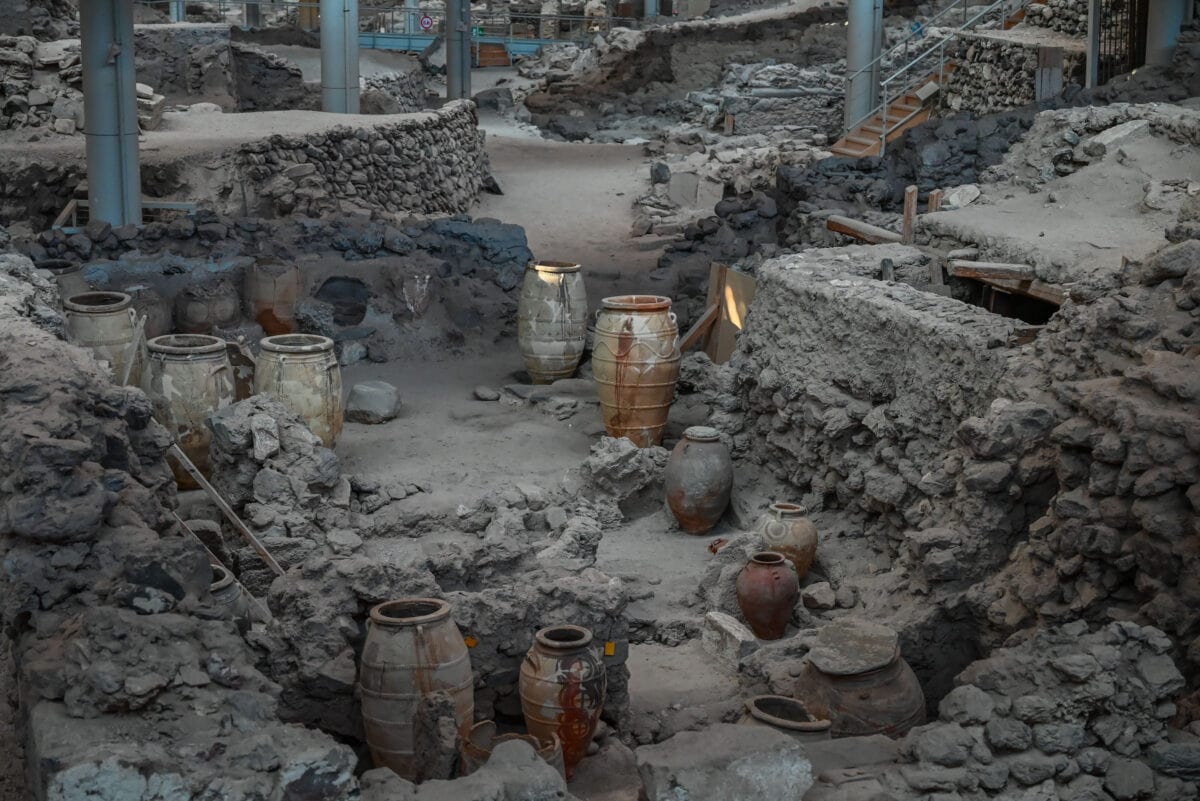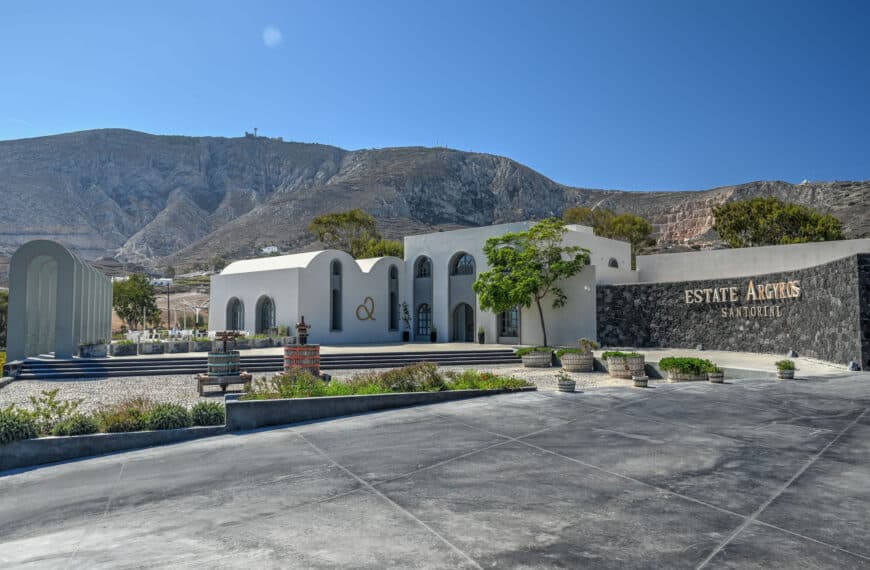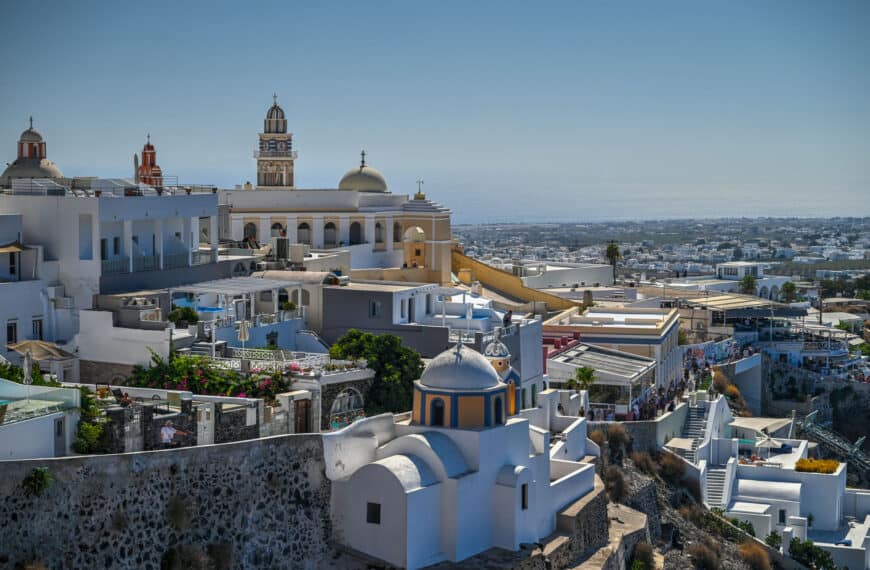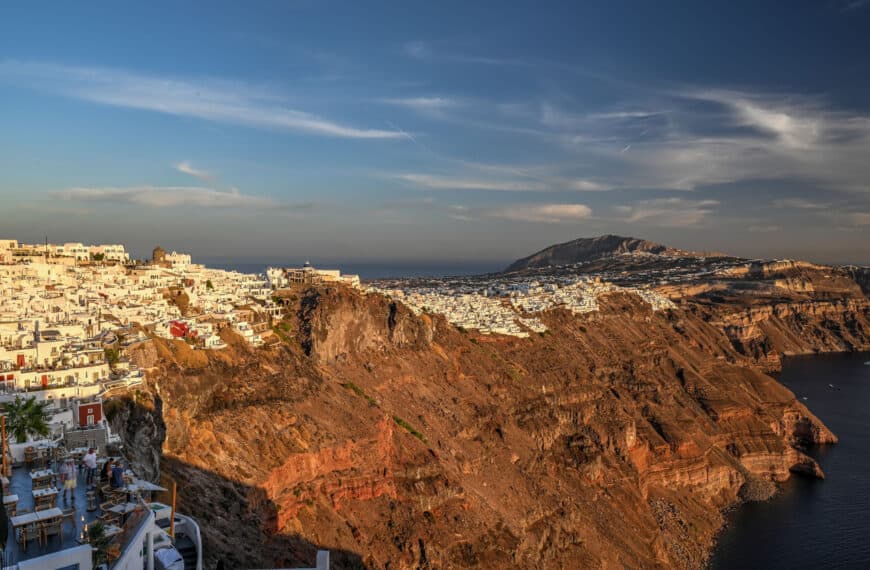You have probably heard of Pompeii – Italy’s ancient city that was buried following the eruption of Mount Vesuvius in 79 AD. But did you know that Santorini has its own version of “Pompei” and that it is a substantially older historical site? The prehistoric settlement of Akrotiri on the island of Santorini (Thíra) is one of the most important archaeological sites in Greece. Because the town was covered in ash following a dramatic volcanic eruption of Thera (Santorini) in the 16th century BC, the preservation of the Akrotiri settlement is quite exceptional. Indeed, you can still clearly see remnants of large buildings and homes of various sizes, streets and alleyways, and beautiful wall frescos. Below we present our Santorini Travel Guide on the Akrotiri Archeological Site, to help you get the most out of your time at this impressive and historical site.
Disclosure: This page (Akrotiri Archeological Site – A Santorini Travel Guide) may contain product affiliate links. At no additional cost to you, we may receive a commission for purchases made through these links. More details can be found on our disclosure and policies page.
You might also be interested in these pages:
Best Things to See and Do in Santorini
Santorini Itinerary Ideas (1 to 5 days)
Santorini Travel Guide: Things to Know Before You Go
Where to Stay on Santorini
How to Get Around Santorini
A Brief History of Akrotiri
The earliest evidence of human habitation in Akrotiri can be traced back to as early as the fifth millennium BC when it was a small fishing and farming village. It wasn’t until the Late Bronze Age, about 4000 years ago, that Akrotiri developed into one of the main urban centres and marine ports in the Aegean Sea. Akrotiri’s prosperity continued for about another 500 years; paved streets, an extensive drainage system, the production of high-quality pottery and further craft specialization all point to the level of sophistication achieved by the settlement.


This all came to an abrupt end, however, in the 16th century BC, following the massive volcanic eruption of Thera (Santorini), which covered the town in lave and ash. As a result, like the Roman ruins of Pompeii after it, it is remarkably well-preserved. Frescoes, pottery, furniture, advanced drainage systems and three-story buildings have been discovered at the site,
The earliest excavations on the island of Santorini were conducted by French geologist F. Fouque in 1870 after some local people found old artifacts in a quarry. However, the extensive modern excavation did not begin until 1967, when Spyridon Marinatos led excavations that revealed the full value of this site — excavations that were later continued by archaeologist Christos Doumas in 1974. Marinatos’s choice of the site proved to be correct and just a few hours into the excavation, the remains of the buried city began to be discovered.
Several excavated artifacts can be found in the (Museum of Prehistoric Thera in Fira). No uninterred human skeletal remains have been found. This indicates that an orderly evacuation was performed with little or no loss of life.
Sadly the archaeological site was closed to visitors between 2005 and 2012 and excavations ceased between 2005 and 2016, due to a combination of factors including an accident involving a collapsed roof and lack of funding.
Today the site is covered by a new bioclimatic roof and walkways are suspended above the archaeological site. In some areas, short paths have been created that allow visitors to walk within the site.
Orientation – How to Get to Akrotiri
The Akrotiri Archeological Site is located in southern Santorini. Despite its distant location, it’s relatively easily reached from pretty much anywhere on the island, with Fira offering the most direct options.

By Car: If driving, it’s only a 20-minute drive from Fira (12 km). A large paid parking lot (€5) is across the street from the site. A large free parking lot is located by Red Beach, a 5-minute walk from the site.
If you haven’t booked your rental vehicle yet, we highly recommend using Discover Cars to get the best rates on your rental in Santorini.
By Bus: There are regular buses from Fira* to the Akrotiri Archeological Site. The ride takes about 20-25 minutes and costs around €2 for an adult.
*Note that the timetables listed are the current timetables, which change throughout the year with increased service during the summer high season
By Group Tour: Another option is to join one of several group tours of Santorini that include a visit to the site.
By Private Transport: If you prefer the comfort of travelling around with a local driver, there are also several options available to tour various spots around the island.
Opening Hours and Admission to the Archeological Site
Opening Hours (2023-2024)
1 April to 31 October: daily from 08h00 – 20h00
1 November to 31 March: daily from 08h30 – 15h30; closed on Tuesdays.
*closed on major holidays
Ticket Prices (2023-2024)
Full: €12, Reduced: €6
*From 1 November to 31 March all visitors pay the reduced rate, unless they are eligible for free entry throughout the year. There is a lengthy list of people eligible for free entry throughout the year (see link below for further details)
*A special combo ticket is available for €15 that includes the entrance fee for 3 sites: the Archaeological Site of Akrotiri, the Archaeological Site of Ancient Thera, and the Museum of Prehistoric Thera. The single ticket can be obtained from the archeological site or the museum you choose to visit first. The single ticket is valid for 3 days.
Tickets can be purchased online in advance on the Greek government’s ticketing website. However, tickets purchased online are non-refundable. You can also easily buy tickets in person at the site entrance, which is what we did.
Visiting the Akrotiri Site
The site is visited by walking along an elevated walkway circuit that was built above the excavated site.
The site is not particularly large – you could probably walk around the site in less than 10 minutes without stopping, but you would be missing out on so much. There are multiple information panels throughout the site that explain the various buildings and structures that you see below. There are also several video exhibits showing how the city and the building interiors might have looked like back in the day.







To better appreciate the layout of the archeological site here is a map of the ancient Akrotiri as currently excavated. Note, however, that the dotted green line indicating the visitor path is incorrect: the actual elevated visitor pathway is much longer and follows the exterior walls more closely, and you exit the site from the same door you came in at the southern end of the complex.
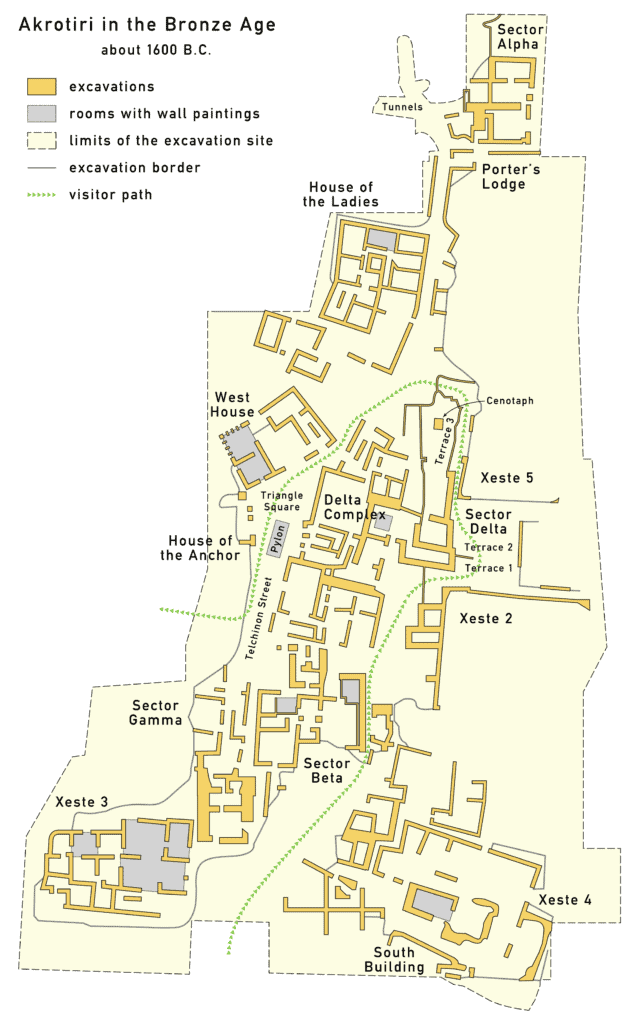
One thing that will catch your attention quickly is the architecturally sophisticated multi-storey buildings that are decorated with exquisite wall paintings. The quality and quantity of the furniture and ceramic vessels are evidence of the town’s prosperity.
The impressive network of streets, alleys, cul-de-sacs, and town squares is also apparent throughout the city. Remnants of clay pipes suggest there may have been some aqueduct systems built at Akrotiri, possibly bringing water from Mount Prophitis Ilias. There is also evidence that many houses were connected to clay pipes that served as a rudimentary sewerage system, which would have followed the natural slope of the land and channelled the waste out to sea.
The numerous imported objects recovered by archaeologists indicate a wide network of communication across the Mediterranean; from Crete to mainland Greece and Egypt.




Some notable buildings at the archeological site include:
Xeste 3: An impressive two-story building with fourteen rooms on each floor. Some of the rooms were connected by multiple doors and decorated with magnificent wall paintings. In one of them, there was a “Lustral basin”, which is considered a sacred area. Based on the architectural features of the building and the themes of the frescoes, it is believed that Xeste 3 was used for the performance of some rituals.
West House: The West House is believed a typical two-story home for a wealthy family. The first floor is occupied by a spacious chamber used for weaving activities, a room for the storage mainly of clay vessels, a lavatory and two rooms, the one next to the other, embellished with magnificent murals.
House of the Ladies: The large, two-storeyed building was named after the fresco with the Ladies and the Papyruses, which decorated the interior. The most interesting architectural feature of the building is a light well constructed at its centre.
When is the Best Time to Visit the Akroriti Archeological site?
We can’t recommend enough arriving when the site opens in the morning. We had the place nearly to ourselves for 30 minutes, until the first tour bus arrived, and loads of people overwhelmed the site at once. Alternatively, if the early morning doesn’t suit you and you would still prefer to avoid the crowds, we recommend arriving about an hour before closing, which should give you enough to tour the site at a comfortable pace. But even if you can’t avoid the crowds, we definitely think a visit to the Akrotiri Archeological Site is worth it.
Regardless of the time you arrive, you are likely to encounter some of the gentle canine guardians of the archeological site.


Nearby Sites and Attractions
Red Beach
Red Beach, also known as Kokkini Paralia, is in our view the most unique and visually stunning beach in Santorini. It’s only a 7-minute walk from the archeological site and definitely worth the slight detour to see it. Though the trail to the beach is potentially hazardous due to landslides, the portion leading to this viewpoint is perfectly safe. For more information on visiting this beach and others, be sure to check out our Guide on Santorini’s Best Beaches.




Akrotiri Lighthouse
Located at the very southwestern tip of the island, a short 13-minute drive from the Archeological site is the Akrotiri Lighthouse, Santorini’s most popular lighthouse and a popular spot to enjoy the sunset. The lighthouse interior is generally closed to the public but you can walk around it and enjoy the views for free. The lighthouse was built by a French company in 1892, making the lighthouse one of the oldest in Greece. Unfortunately, there are no buses that can take you to the lighthouse
Megalochori
If coming from Fira or Imerovigli, you might want to stop and visit this charming and authentic Santorini Village. It’s a great place to just wander the different streets and alleyways away from the crowds of Oia and Fira without missing out on beautiful churches and white-washed Cycladic architecture.






Megalochori is also where you will find our favorite winery in Santorini: Gavalas Winery. It’s a small boutique winery that has been family-run for 5 generations (over 300 years). The cute authentic decor and attention to detail made it a memorable experience.





Megalochori is only a 10-minute drive from the Akrotiri site, and can easily be reached by bus along the same bus line between Fira and Akrotiri. For more information on visiting this charming village, be sure to check out our Guide on the Best Things to See and Do in Megalochori.
Preparing a trip to Santorini?
You might also be interested in these pages:
Best Things to See and Do in Santorini
Santorini Itinerary Ideas (1 to 5 days)
Santorini Travel Guide: Things to Know Before You Go
Where to Stay on Santorini
How to Get Around Santorini
Preparing a trip to Greece?
You might be interested in these Greece pages:
Top Things to See and Do in Greece
Two-Week Greece Itinerary (including Mykonos and Santorini)
Greece Travel Guide: Things to Know Before You Go
How to Travel Around Greece
We also highly recommend these guidebooks:
Rick Steeves Greece
Lonely Planet Greece
Photography Gear
If you like our photography, you might be interested in some of the gear we use to shoot our travel and hiking destinations.
Camera Body – Nikon Z 6ii Fx-series Mirrorless Body
Main Lens – NIKON 24-120mm F/4G ED VR AF-S
Zoom Lens – Sigma 745-306 150-600mm f/5-6.3
Polarizing filters – Urth Circular Polarizing (CPL)
Camera Tripod – K&F Concept 64-inch Camera Tripod
Mini-tripod – Lammcou Flexible Camera Tripod
Camera/hiking backpack – Vanguard Alta Rise 48 Backpack
Universal Travel Adapter – VYLEE Universal International Power Travel Plug
Other Travel Essentials
Travel Insurance
SafetyWing is a travel insurance company that offers comprehensive coverage for travellers. Includes Medical Insurance and Travel Insurance. Primarily geared towards long-term travellers, digital nomads, and expats.
e-Sim cards
Airalo is the world’s first and largest eSIM store with eSIM plans for 200+ countries and regions worldwide. With Airalo eSIMs, travellers can get connected the moment they land at their destination and avoid nasty data roaming charges
eSIMS are a sustainable alternative to single-use SIM cards – they are 100% digital, require less energy to produce and be re-used rather than disposed of.
Car Rentals
Discover Cars is our go-to website for car rentals. We almost always find our preferred rate there.
Transfer from Airport
Welcome Pickups is our favourite private transfer service, which you can pre-book at a fixed price. Currently available in 220 cities all over the world (mostly in Europe, but with several major cities in Asia, the Middle East and the US).
Kiwitaxi is another private transfer service – we haven’t tried it yet, but it’s currently available in a few more countries (102 as of 2024).
Hotels and Accommodations (coming soon)
Photography Prints
If you found this blog useful, you can help support our blog by purchasing low-cost digital prints. Printed physical prints are also available for purchase.








—–
Well, that wraps it up! We hope you enjoyed our Santorini Travel Guide on the Akrotiri Archeological Site and that it will prove useful for planning your trip to Santorini.
—–
You might also be interested in these related pages:
